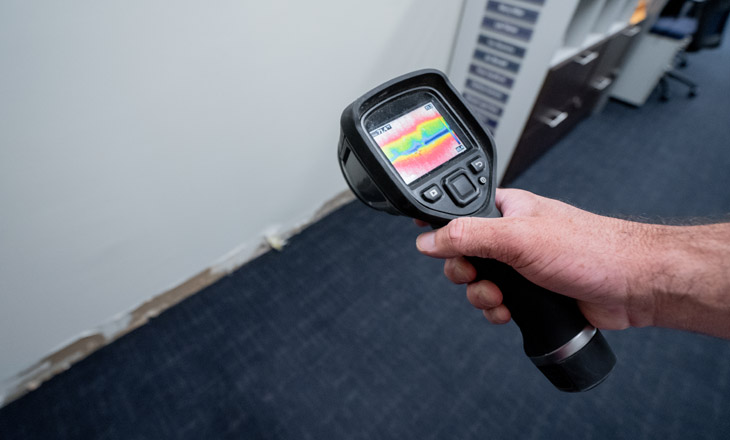Leading Water Leak Detection Methods to Safeguard Your Building from Water Damages
Leading Water Leak Detection Methods to Safeguard Your Building from Water Damages
Blog Article
Innovative Solutions for Early Detection of Water Leaks in Buildings and Framework
From sophisticated leakage detection innovations to the implementation of IoT sensing units for real-time surveillance, the landscape of leakage avoidance is advancing rapidly. Automated water flow analysis systems are improving how leakages are identified and addressed, leading the way for a proactive method to water leakage detection.
Advanced Leak Discovery Technologies
Advanced leakage detection modern technologies, geared up with sophisticated sensors and algorithms, play a vital duty in swiftly identifying and identifying water leakages in different settings. These technologies utilize a combination of acoustic, thermal, and electro-magnetic noticing methods to spot leaks accurately. Acoustic sensing units find the noise of running away water, permitting for accurate localization of the leak resource. Thermal imaging finds temperature level adjustments triggered by water leakage, offering one more reliable method for leakage identification. Electro-magnetic sensing units can recognize adjustments in magnetic fields triggered by water, offering yet another layer of leak discovery capacity.

IoT Sensors for Real-Time Surveillance
In the realm of modern-day water leak discovery, the assimilation of IoT sensing units for real-time monitoring represents a crucial advancement in boosting proactive leak discovery capacities. These sensing units provide continual tracking of water systems, offering real-time data on water circulation rates, pressure variants, and temperature modifications. By leveraging IoT innovation, these sensing units can discover even the tiniest abnormalities in water use patterns, enabling very early identification of potential leaks prior to they escalate right into significant concerns.
IoT sensors transmit information to a central platform, where sophisticated formulas analyze the information and create notifies or alerts when abnormalities are detected. This real-time tracking capacity allows homeowner or center supervisors to without delay attend to leakages, decreasing water damages, minimizing fixing expenses, and saving water resources.
Moreover, IoT sensing units can be integrated with building management systems, enabling automatic reactions to found leaks, such as shutting down water shutoffs or triggering pumps to mitigate the impact of leakages. In general, the execution of IoT sensors for real-time tracking significantly boosts the performance and efficiency of water leak discovery in buildings and facilities.
Equipment Learning Algorithms for Leak Prediction

One trick benefit of making use of artificial intelligence for leak forecast is its ability to continually find out and enhance its accuracy gradually. As even more data is collected and fed right into the algorithm, it can fine-tune its predictions and adjust to transforming conditions, inevitably boosting the reliability of leakage discovery systems.
Moreover, maker learning formulas can assist in recognizing refined indications of leaks that might go undetected by typical tracking methods. water leak detection. By evaluating complex data embed in real-time, these algorithms can offer very early warnings and informs, enabling timely intervention and preventative upkeep to reduce possible water damage and associated prices
Utilizing Thermal Imaging for Leakage Discovery
Thermal imaging technology offers a promising method for identifying water leaks in numerous systems and facilities. By using infrared radiation and temperature level variances, thermal imaging cameras can determine hidden leaks that are not conveniently noticeable to the naked eye. When water gets away from pipelines or structures, it commonly transforms the temperature of the bordering location, developing temperature differentials that thermal video cameras can catch. These temperature level abnormalities are then equated into visible images, highlighting the precise place of the leak.
One of the crucial benefits of thermal imaging for leak detection is its non-intrusive nature. Unlike standard methods that may require breaking into walls or floorings to find leaks, thermal imaging permits non-destructive screening. This not just conserves time and lowers expenses but also reduces disturbance to the structure or facilities being examined. Additionally, thermal imaging can promptly scan huge areas, supplying a thorough introduction of possible leakage resources in a timely way. Generally, the use of thermal imaging technology boosts the efficiency and accuracy of water leak detection, making it a useful tool for keeping the honesty click site of structures and infrastructures.
Automated Water Circulation Evaluation Systems
Just how can automatic water flow analysis systems transform the discovery and monitoring of leaks in various systems and frameworks? Automated water circulation evaluation systems offer a positive technique to leakage detection by continuously keeping track of water flow prices and patterns. By establishing standard information, these systems dig this can promptly recognize inconsistencies that may suggest a leak, enabling timely treatment to avoid substantial damages.
These systems make use of sophisticated algorithms to evaluate real-time information and provide prompt notifies when anomalies are found, permitting speedy activity to be taken. Additionally, computerized water flow analysis systems can be incorporated with structure management systems or IoT systems, boosting total efficiency and allowing remote tracking capabilities.
Additionally, the information accumulated by these systems can be utilized for predictive upkeep objectives, aiding to recognize potential powerlessness in the framework prior to leakages happen. In general, the implementation of computerized water circulation evaluation systems can significantly boost leak detection and administration methods, inevitably bring about cost savings, lowered water wastefulness, and enhanced sustainability in structures and framework.

Final Thought
In conclusion, the integration of innovative leakage detection technologies, IoT sensors, device understanding algorithms, thermal imaging, and automated water circulation analysis systems offers ingenious services for very early discovery of water leakages in buildings and facilities. These innovations make it possible for real-time tracking, prediction of leaks, and effective discovery approaches to stop water damages and wastefulness. Implementing these options can help in maintaining the stability and sustainability of water supply in different setups.
Report this page